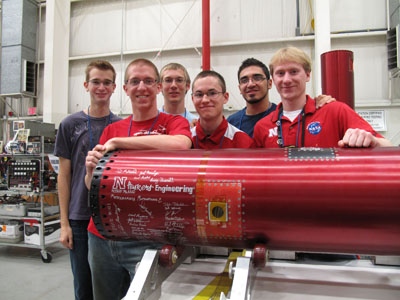
CSE students Avery Quandt and C. J. O'Hara were involved in the NASA's Student Launch Projects, which required participants to work in teams to design and build a reusable rocked that can be launched one mile. In the following, Quandt talks about the competition and his career goals.
Bits and Bytes (B&B): Can you explain your the main objective of the competition?
Avery Quandt (AQ): The main objective of the University Student Launch Initiative is to design and build a rocket with a science/engineering payload that will reach an altitude of 5,280 feet (1 mile). Along the way there are several design reviews and documents to write and there are several other areas that are awarded such as best looking rocket, the educational engagement award, best looking website, and best payload.
B&B: How long did you prepare your project?
AQ: Our team has been working on the project since the writing of the team's proposal. The proposal was due in August 2012, so it has been a year-long project.
B&B: What is the preparation process like?
AQ: The preparation process was much like any other CSCE group project (like CSCE 230's Altera Project and CSCE 236's Arduino Robot Project). You begin by brainstorming ideas, finalize the idea, write the reports, and finally build the physical item.
B&B: Can you tell us about your experience with the American Institute of Aeronautics and Astronautics?
AQ: I joined the American Institute of Aeronautics and Astronautics at the beginning of my freshman year. In high school I had participated in the FIRST Robotics Competition and wanted to find a similar club at UNL. The AIAA club was looking to start a NASA Lunabotics team as well as continuing the rocket team and the DBF aircraft team. I joined the Lunabotics team and became a member of the rocket team the following year. Getting to build these projects is extremely rewarding. It is also a great hands-on and teamwork experience. Plus, getting to travel to 3 different NASA facilities has been fun!
B&B: What do you hope to do when you graduate?
AQ: When I graduate, I'm not too picky about what I end up doing (I like hardware and software), but working on cutting edge projects such as technology that is going to space is certainly preferable.
B&B: Why would you encourage others to get involved?
AQ: I would encourage others to get involved because student engineering clubs are a win-win. You have fun, meet new people, gain experience with teamwork and working on projects, and it looks great on your resume!